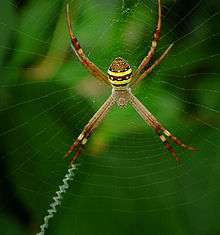Argiope keyserlingi
Argiope keyserlingi is a common species of orb-web spider found on the east coast of Australia, from central New South Wales to northern Queensland.[1] It is very similar in appearance to the closely related north Queensland species, Argiope aetherea. A. keyserlingi is commonly found in large populations in suburban parks and gardens, particularly amongst the leaves of Lomandra longifolia. Like many species of orb-web spider, A. keyserlingi shows considerable sexual size dimorphism, with the females being many times larger than the males. Mature females can be seen during the summer months and it is not uncommon to see multiple males on the web of one female.
| St Andrew's Cross spider | |
|---|---|
 | |
| Juvenile female Argiope keyserlingi from Brisbane | |
| Scientific classification | |
| Kingdom: | Animalia |
| Phylum: | Arthropoda |
| Subphylum: | Chelicerata |
| Class: | Arachnida |
| Order: | Araneae |
| Infraorder: | Araneomorphae |
| Family: | Araneidae |
| Genus: | Argiope |
| Species: | A. keyserlingi |
| Binomial name | |
| Argiope keyserlingi Karsch, 1878 | |
This spider is commonly known as the St Andrew's Cross spider, due to the construction of bands of silk forming the arms of an X-shaped cross, similar to the one upon which St. Andrew is traditionally said to have been crucified. Juveniles of this species sometimes build a spiral-shaped pattern of silk.[2] Termed web decorations or stabilimenta, these bands are thought to increase prey capture in this species, however, in other species they have been found to protect the spider against predators.
A. keyserlingi is an important model species in studies of spider ecology and behaviour. Using this species scientists have investigated sperm competition, sexual size dimorphism, cryptic female choice, the role of pheromones in mating behaviour and the function and evolution of web decorations.
Name
The Latin species name was chosen to honor arachnologist Eugen von Keyserling. The spider is also commonly called the crucifix spider.
Footnotes
- Levi H. W. (1983). "The Orb-Weaver Genera Argiope, Gea, and Neogea from the Western Pacific Region (Araneae: Araneidae, Argiopinae)" (PDF). MUSEUM OF COMPARATIVE ZOOLOGY. Harvard University. Retrieved 2018-02-27.
- Whyte, Robert; Anderson, Greg (2017). A Field Guide to Spiders of Australia. Clayton South Vic. 3169: CSIRO publishing. p. 80. ISBN 9780643107076.CS1 maint: location (link)
- Blamires et al. 2007
References
- Blamires, Sean J.; Hochuli, Dieter F. & Thompson, Michael B. (2007): Does decoration building influence antipredator responses in an orb-web spider (Argiope keyserlingi) in its natural habitat? Australian Journal of Zoology 55: 1-7. doi:10.1071/ZO06098 — PDF
- Platnick, Norman I. (2008): The world spider catalog, version 8.5. American Museum of Natural History.
External links
| Wikimedia Commons has media related to Argiope keyserlingi. |
| Wikispecies has information related to Argiope keyserlingi |